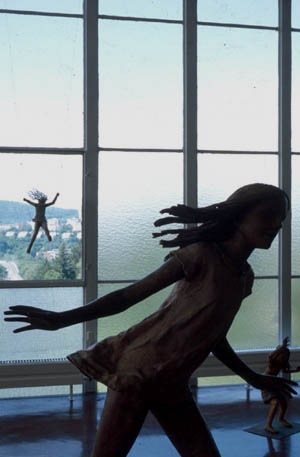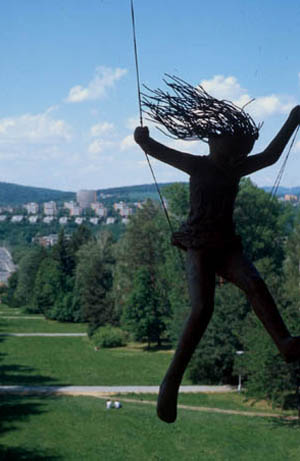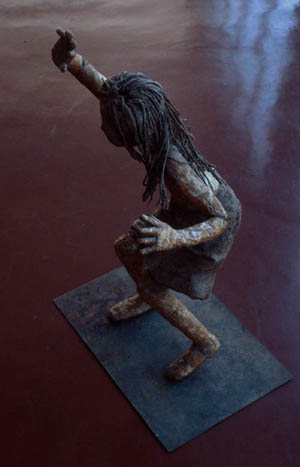
GNOMIC WORKS: THE SCULPTURAL WORKS OF KURT GEBAUER
My first encounter with the work of Czech sculptor Kurt Gebauer occurred in 1995, the year his Pyramidal Dwarf (1992) appeared in St. George Square, in the third courtyard of Prague Castle. This pyramidal stone object (an all but abstract gnome) was situated in such a way that it aligned with the spires of St. George church but deferred to the majestic gothic pile of St Vitus cathedral, a conflation of effects based on the idea of the pinnacle and the blessed pointed head of ecclesiastical architecture. The irregular sandstone form (385 cm.) was fractured in two places -- one intended, one caused by vandals -- perhaps a coincidence, but certainly reminiscent of Plecnik's obelisk, which also broke when it was being erected in the same courtyard over sixty years earlier. According to Gebauer, this particular sculpture was an exercise in "architectural logic" and "not a problem of genre", although it played in no small way with the synchronic vagaries of aspiration itself. Gebauer later explained the "logic" of the composition in purely formalistic terms -- as negotiating the primary, gothic syntax of the third courtyard -- suggesting that, in this case, the primitive object transcends the anxiety-ridden genre of politicized works of art. (Pyramidal Dwarf was subsequently moved to the Deer Moat, "below Prague Castle", where it resides at this time amid the verdure of the naturalistic ravine that slices through the castle mount.)
Fig. 1 (above, left) - Running Girl, and On A Swing
It was immediately following this encounter with the tectonic, giant 'dwarf' (a complete contradiction/contraction of terms), that I met Kurt Gebauer, finding him at his home not coincidentally adjacent to the residence of President Vaclav Havel -- as they have been friends since Havel's days as dissident playwright -- and not far from the Castle. In his garden were the various grotesque gnomes (Trpaslici) -- fiberglass/resin versions -- that he first illicitly deployed in 1985 (at Galerie H, Kostelec nad Cernymi Lesy) in a mock send-up of so-called "normalization" under the Communists. Dwarf Monument, a large menacing dwarf with arm raised, and Dwarf Dog also first appeared in 1985, in Vojanovy Sady, Prague. Indeed, Dwarf Monument later went on tour, in 1987, travelling to New York, Paris, Berlin, Regensberg, and Helsinki. These were the formal precursors to Pyramidal Dwarf, though the ideas animating them are traceable to a set of drawings called Normalization (two dwarfs beating a skull) from 1972. Gebauer finally created the first set of dwarfs in 1985, 8 in 10 days, as a parody of Czech society in the last, dark days of communist rule.
 In the 1950s and 1960s, Czech artists had agitated against the "genocide of gnomes" -- mocking the roundup of bourgeois cultural practices perpetrated by the State Security (STB) apparatus. In Gebauer's imagination this confrontation took the form of a hybridization of forms deriving monumentality from the Social Realist sculpture of the period and combining it with the diminutive stature typical of the garden gnome/dwarf -- a clash between totalitarian diktat and good old-fashioned bourgeois bad taste. Gebauer's gnomes became -- post Velvet Revolution (1989) -- bored, idle secret police-type gnomes -- unable to cope (in 1995) with the post-communist state of things. One guzzled beer from a tankard, half reclining on one elbow slowly rotting into the earth. Other gnomes leaned, perched and hid amid the ramshackle garden. One (Myslitel or Thinker) -- seated on the wall of the garden separating Gebauer's residence and Havel's -- was painted red. Another (Bachar) was perched in the trees and held a crude wooden rifle 'guarding' (as it were) Havel's flank. Another had 'leapt' the wall entirely and taken up residence in Havel's garden. This latter gnome, code-named Fizl, was spying (hand raised over eyes) ostensibly for interlopers, but more likely on President Havel ("Making sure he was working", said Gebauer). Also in Gebauer's garden (a kind of morgue for his retired exhibitions) were the buxom bathing damsels from Bohemian Pond (c.1988, re-deployed in Vojanovy Sady, Prague, in 2000).
In the 1950s and 1960s, Czech artists had agitated against the "genocide of gnomes" -- mocking the roundup of bourgeois cultural practices perpetrated by the State Security (STB) apparatus. In Gebauer's imagination this confrontation took the form of a hybridization of forms deriving monumentality from the Social Realist sculpture of the period and combining it with the diminutive stature typical of the garden gnome/dwarf -- a clash between totalitarian diktat and good old-fashioned bourgeois bad taste. Gebauer's gnomes became -- post Velvet Revolution (1989) -- bored, idle secret police-type gnomes -- unable to cope (in 1995) with the post-communist state of things. One guzzled beer from a tankard, half reclining on one elbow slowly rotting into the earth. Other gnomes leaned, perched and hid amid the ramshackle garden. One (Myslitel or Thinker) -- seated on the wall of the garden separating Gebauer's residence and Havel's -- was painted red. Another (Bachar) was perched in the trees and held a crude wooden rifle 'guarding' (as it were) Havel's flank. Another had 'leapt' the wall entirely and taken up residence in Havel's garden. This latter gnome, code-named Fizl, was spying (hand raised over eyes) ostensibly for interlopers, but more likely on President Havel ("Making sure he was working", said Gebauer). Also in Gebauer's garden (a kind of morgue for his retired exhibitions) were the buxom bathing damsels from Bohemian Pond (c.1988, re-deployed in Vojanovy Sady, Prague, in 2000).All of this explication led to a conversation on the nature of representation (vis-ŕ-vis repression), which to Gebauer requires going "only so far". To go any further than "only so far" risks either the atrocious or the bathetic. For Gebauer, this translates into an artistic process that unveils both natural and unnatural "chemical" cultural and personal relationships (elective affinities, perhaps). Nature and human nature combine in relationships that are sustainable and pleasant. Nature and culture often combine, on the other hand, to produce the tragic.
Fig. 2 (above, right) - On A Swing
Gebauer's exceptional restraint is focussed in a unique intellectual-emotional realm that combines concepts and feelings. This liminal zone is "the heart" -- the true seat of the mind. The work often is mordantly comic and even dark, but it is never self-conscious or merely parodic. The art of (the sometimes lacerating) gesture is at the heart of this zone (half-nether region) -- a figure of resistance to both dogma and to refinement. It is a half-inarticulate, half-articulate shadow-land where some things are best left unsaid (pace Wittgenstein). From this extraordinary place that resides in everyone still breathing (thinking/feeling) comes, however, whispers, echoes, and cries -- of both primordial angst and raucous, preternatural joy.
The limits of Gebauer's art are self-imposed. Working typically (and deliberately) with found rock forms, plaster, or resin, Gebauer shapes these raw materials only so far as necessary -- the work is less gnomic than Beuys, and most Fluxus fabrications, but related in the sense that Gebauer has sought not to create aesthetic objects so much as to provoke aesthetic reflection. A very small, delicate portion of his production is almost fully realized 'life forms' -- not quite full-scale to indicate the therapeutic degree of separation from realism Gebauer maintains in the rare instances when he ventures in the direction of full-blown figuration. Some of these figures from the 1970s (Weirdie Girl, Running Girl, and On A Swing) are extraordinarily lyric (and 'singular', or compressed into a state of extraordinary tension). In the case of Running Girl (1975), every gesture of the young girl 'in flight' contains the expression of unfettered freedom that her almost startled face conveys. The flying hair, the folds and creases of her wind-swept shirt dress, and the out-swung arms all portray the same elemental joie de vivre and innocence coupled with nervous tension.
Fig. 3 (below, left) - Weirdie Girl
 It was Gebauer's retrospective exhibition in the famous industrial city of Zlín ("home" of Bata) in 2001 (at the State Gallery) that sealed my impressions regarding Gebauer's mysterious poetic sensibility, something operating outside of/beyond any identifiable norm. Gebauer's famous Studio of Universal Sculpture at the Academy of Arts, Architecture and Design (Prague) also produced a parallel exhibition in Zlín by his students ("Universal Sculpture") that was at best provocative and at worst incoherent. Gebauer's effect was evident in the rustic materiality of the presentations and in the wry, sometimes absurd ideational constructs pictured, but what was missing was that exquisite personal sensibility that pushes his work into an indefinable category, a category that includes a prescience for the sublime and the ridiculous, but a personal territory that also contains secret algorithms for sustaining life against all forms of extremism -- something that cannot be transmitted to students nor captured, thankfully, in words.
It was Gebauer's retrospective exhibition in the famous industrial city of Zlín ("home" of Bata) in 2001 (at the State Gallery) that sealed my impressions regarding Gebauer's mysterious poetic sensibility, something operating outside of/beyond any identifiable norm. Gebauer's famous Studio of Universal Sculpture at the Academy of Arts, Architecture and Design (Prague) also produced a parallel exhibition in Zlín by his students ("Universal Sculpture") that was at best provocative and at worst incoherent. Gebauer's effect was evident in the rustic materiality of the presentations and in the wry, sometimes absurd ideational constructs pictured, but what was missing was that exquisite personal sensibility that pushes his work into an indefinable category, a category that includes a prescience for the sublime and the ridiculous, but a personal territory that also contains secret algorithms for sustaining life against all forms of extremism -- something that cannot be transmitted to students nor captured, thankfully, in words.Gavin Keeney (April 2002)
Version 1.1 - Gnomic Works (New Presence, Summer 2002)
All photographs by GK
OUTTAKES
Krajská galerie výtvarného umění ve Zlíně (State Gallery, Zlín)
Kurt Gebauer (CV, Chronology, etc.) ...
Running Girl (Middelheim Sculpture Graden, Belgium)
*The ‘great’ industrial city of Zlín was re-worked along functionalist principles from a plan by Frantisek L. Gahura (a student of Jan Kotera) in the mid to late 1930s. Le Corbusier was consulted in 1920s and proposed a variation on his Ville Radieuse (c.1930). “The simple, box-like, red-brick houses Bata built to house his workers still are among the best housing the city has to offer, and the style planned for the city laid out during the First Republic can still be seen in spots. The unadorned brick, steel, concrete and glass surrounded by greenery in this garden city make Zlín a model of urban planning. Bata also built schools, research institutions, a film studio and hospital.” --More on Zlín (Archiv/Radio CZ)
BIBLIOGRAPHY
Libuse Gebauerova (editor), texts by Kurt Gebauer, Josef Hlavacek, Pavla Pecinkova, and Dan Merta, Kurt Gebauer: Obrazy z Dejin Vlastniho Statu (Pictures from the History of a Personal State) (Praha: Stary Kralovsky Palac, 1995)
Libuse Gebauerova (editor), texts by Kurt Gebauer, Joseph Hlavacek, and Tomas Pospyszyl, Kurt Gebauer: Magicka zena Praha / Znovuvstoupeni do ceskeho rybnika (Prague: The Magical Women / The Czech Pond Revisited) (Prague, 2000)
Libuse Gebauerova (editor), texts by Josef Hlavacek, Jiri Setlik, and Kurt Gebauer, Atelier Veskereho Socharstvi, (The Studio of Universal Sculpture) (Praha: Academy of Arts, Architecture & Design/Prague Castle Administration, 1998)